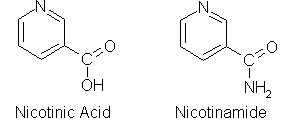Niaspan
Niacin, also known as nicotinic acid or vitamin B3, is a water-soluble vitamin whose derivatives such as NADH play essential roles in energy metabolism in the living cell and DNA repair. The designation vitamin B3 also includes the amide form, nicotinamide or niacinamide. Severe lack of niacin causes the deficiency disease pellagra, whereas a mild deficiency slows down the metabolism, which in turn decreases cold tolerance and is a potential contributing factor towards obesity. more...
Nicotinic acid was first discovered from the oxidation of nicotine. When the properties of nicotinic acid were discovered, it was thought prudent to choose a name to dissociate it from nicotine and to avoid the idea that either smoking provided vitamins or that wholesome food contained a poison. The resulting name 'niacin' was derived from nicotinic acid + in.
Nicotinic acid reacts with hemoglobin and myoglobin in meat to form a brightly coloured complex, and thus has been used as a food additive, typically to improve the colour of minced (ground) meat. However, sometimes excess niacin is added to the meat during processing. Though still licensed as a food colouring agent in some countries, it is not licensed as such in Europe.
The liver can synthesize niacin from the essential amino acid tryptophan, but the synthesis is extremely slow and requires vitamin B6; 60 mg of tryptophan are required to make one milligram of niacin. Bacteria in the gut may also perform the conversion but are inefficient. For this reason, eating lots of tryptophan is not an adequate substitute for consuming niacin.
Niacin in large quantities is a vasodilator. Large amounts of niacin (either from vitamin B3 tablets or from treated meats) may cause dose related, harmless and short-lived sensations ranging from a mildly pleasant warm flush to tingling to extreme skin flushing resembling a sunburn, itching, gastric disturbances, and lowering of blood pressure. The amide form (strictly speaking a provitamin) does not cause these side effects, but is also not as easily assimilated by the body.
Large doses of niacin are sometimes prescribed to combat high blood pressure, and also to lower blood cholesterol levels. Pharmacologic doses of niacin (1.5 to 6 grams/day) typically reduce LDL cholesterol levels by 10 to 25 percent and triglyceride levels by 20 to 50 percent. HDL cholesterol levels are also typically increased by 15 to 35 percent.1 Brand-name medications include Niaspan®, Niacor® and Nicolor®. Treatment doses cause flushing in individuals not previously exposed to large doses of niacin, so titration and acclimation to increasing doses is preferred upon starting the medication. The niacin treatment discoverer, Abram Hoffer, and other orthomolecular proponents generally add a full spectrum vitamin B formulation, such as B-50, and 1 to 4 times as much vitamin C as niacin to reduce liver stress. Liver cell activation and stress is easily monitored in the liver enzyme panel along with blood cholesterol measurements. Because of the liver stress associated with heavy alcohol consumption, regular drinkers and alcoholics may experience antabuse-like reactions with pharmacologic levels of niacin.
Read more at Wikipedia.org



